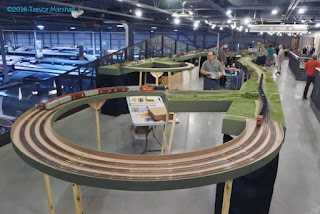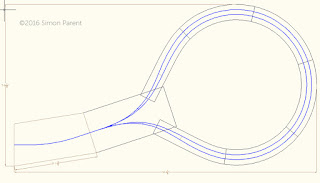But operationally, we tend to set up in one of two configurations. Most of us are in Southern Ontario but if Workshop member Simon Parent joins us from the Montreal area, we set up in a loop-to-loop format - as we did at Exporail in August and at the Copetown Train Show in March:
However, if Simon can't make it, we typically set up in a point-to-point configuration, as we plan to do at the upcoming Brampton Model Railway Show:
The two configurations are very different from an operations perspective - and it's fair to say that most of the members prefer the loop-to-loop arrangement. It's easier to keep trains rolling during an exhibition when they turn themselves. More importantly, the use of loops instead of short (4' long) "train length turntables" means we can run longer trains. Much longer.
 |
| Loops allow us to run long trains, like this coal drag behind a CNR 2-10-2. |
 |
| Without the loops, our trains tend to be only a few cars long. That said, short trains look just fine behind small steam power. |
But Simon can't always join his friends in southern Ontario - not at every show, anyway. And since the current loop set is also part of his home layout, we can't expect him to leave the loops in our area.
So, as we conducted our post-mortem on Exporail, Simon volunteered to build a pair of loops for the group in southern Ontario. We'll pay for his materials and the group will own these collectively. Since many of us already have home layouts and/or modules, the loops have been designed to take up as little space as possible when stored. They'll be based on construction techniques that Simon has proven on his own modules so we already know they're going to work well.
Our initial plan was for a simple loop at each end. But after some discussion, we decided that adding a double-ended siding within each loop - similar to Simon's "Staging Loop", but with only two tracks instead of three - would not take up much additional space.
The advantages are definitely worth it. The second track will provide us with some much-needed additional flexibility for exhibits. We can store a train at each end of the run, or use the loops as sidings for meets.
Here's the current design for the Ontario Loops*:
Both loops will be identical. If I recall, the trapezoid section at lower left should be reversible so we can bend the loops in either direction. The two wide sections will get very basic ground cover, while the loops themselves will be unscenicked - just like the loops we currently use.
 |
| Simon's three-track staging loop, with scenery on the junction sections and bare wood on the staging portions. Shown at Exporail 2016. |
Of course, if Simon is joining us and bringing his loops, then we'll be able to attach the two Ontario Loops to a variety of positions - perhaps off one branch at Dunham Junction, and off the second route through the interlocking on Simon's single-track loop. Now that would be quite the layout...
Thank you, Simon, for volunteering to build these (in your spare time, of course). Your friends in Ontario are in no rush for them, but we look forward to putting them to good use...
(*"Ontario Loops": Not their official name - yet. But I had to call them something for this post...)




No comments:
Post a Comment
Your comment will be visible after approval from the moderators. Thanks for your patience.